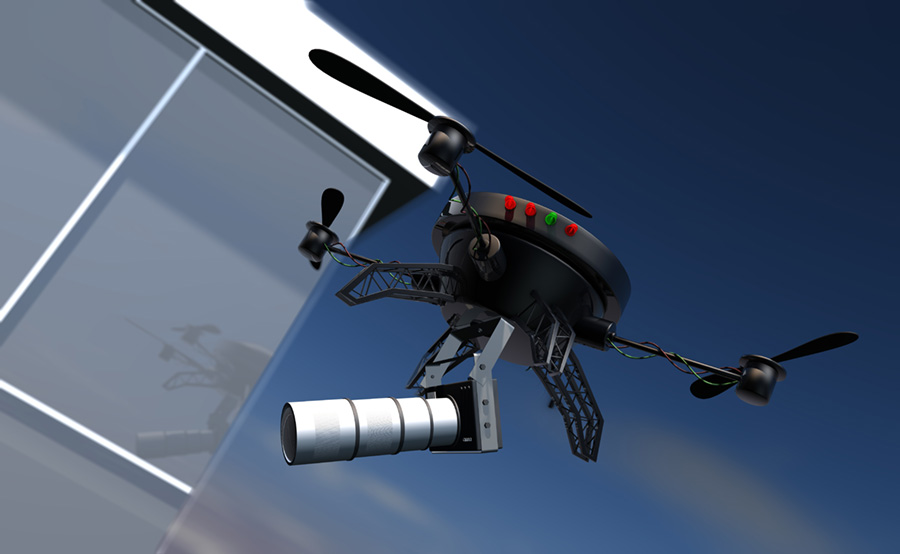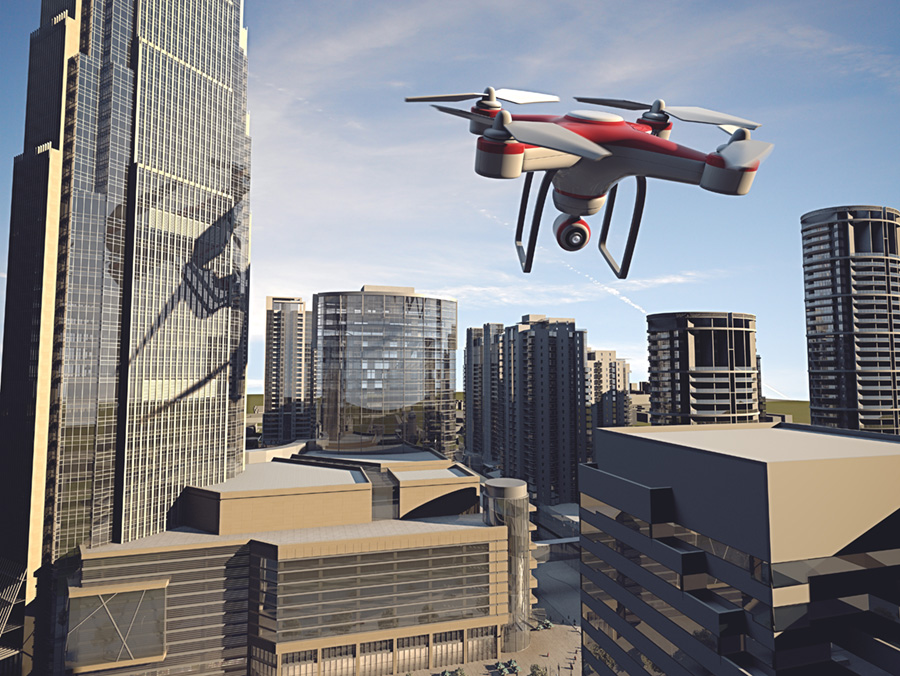Unmanned aerial systems (more commonly known as drones) are soon to be an integral part of the design and construction industry. The U.S. Federal Aviation Authority (FAA) is moving forward on setting up general requirements and granting permits so that commercial entities can tap into the potential of drones for a broad range of observation and exploration purposes.
 The hesitancy of the FAA to authorize general drone use is based on safety and privacy concerns. Interference with manned aircraft and the dangers to people and property from accidents are primary concerns. Popular opposition to both the invasion of privacy aspects of drone use and the noise is also influential in forcing the FAA to proceed cautiously.
The hesitancy of the FAA to authorize general drone use is based on safety and privacy concerns. Interference with manned aircraft and the dangers to people and property from accidents are primary concerns. Popular opposition to both the invasion of privacy aspects of drone use and the noise is also influential in forcing the FAA to proceed cautiously.
The FAA’s Release of Proposed Rules
The FAA has worked on rules for commercial use of drones for several years and recently published long-awaited interim rules and proposed final rules on the commercial use of small drones. The release of proposed rules only begins a period of public comment and possible revision that could take as long as two years before rules for the commercial use of drones take full effect. Among the major provisions are these:
- A commercial drone must not weight more than 55 pounds and can only be flown within line of sight of the operator or assigned observer. The drone must only be flown in daylight and cannot operate over any persons not directly involved in the operation. The draft also limits flying speed to 100 miles per hour and no higher than 500 feet above ground level.
- Pilots of drones are considered “operators” who will be required to pass an aeronautical knowledge test and be vetted by the Transportation Security Administration. Upon passing, they would receive a permit that would have to be renewed every two years as well as an operator’s certificate with a rating for small drone control.
Although drones appear to be inexpensive machines, it is obvious that the price of a drone will probably be the least significant cost factor in the commercial use of drones. Permitting and personnel expenses are likely to move the feasibility of commercial drone options out of casual or limited business operations. The FAA estimates that it would cost $300 to become certified, including fees and preparation costs.
Drone Operators Must Have Risk Controls and Insurance Coverage
Until the FAA released the proposed rules, only specific drone uses by specific users were allowed. Now, many companies—including architecture and other design firms—are ready to put drones into use.
Certainly, any legal drone use for design and construction will have to meet the commercial restrictions. Whether an architecture firm owns and operates the drone or subcontracts for its use with a commercial provider, the entity operating the drone will have to have appropriate risk controls and insurance coverages.
The insurance industry is moving forward on preparing coverage for drone use. The issue is not one of professional liability insurance coverage; for instance, the Victor program covers the professional liability of firms using drones as a tool to allow them to perform their professional obligations. Professional liability coverage, however, only applies if the underlying cause of action was based on a wrongful act or omission in the performance of professional services and not on a wrongful act or omission in the operation of a business that happens to provide professional services. And professional liability insurance never covers a criminal activity which could result from unpermitted drone operations.
The insurance industry, however, has been concerned with general liability exposure intrinsic in the commercial use of unmanned aircraft and has reacted. Now, the Insurance Services Office (ISO), the private organization that develops coverage standards for the insurance industry, recently developed and filed a variety of general liability insurance endorsements addressing drone exposures to allow for maximum flexibility with this newly emerging exposure.
Firms that are anticipating the legal use of drones should check with their brokers about their general liability coverage and the new ISO endorsements. Firms that subcontract for drone operation services should make sure that the firm operating the drone has appropriate coverage for the physical damages a drone could cause, coverage for personal injury claims such as invasion of privacy, and contractually agrees to stand behind its services. Also, the firm should check its general liability coverage and its management liability coverage so that it is not held responsible for imputed negligence or negligence in the selection and management of a drone operator who does not have appropriate coverage.
Architecture Firms Have to Recognize Professional and Business Exposures
 There are many scenarios where an architecture firm operating a drone or directing its use by a subcontractor could find itself liable for harm. In some cases, this liability would be considered a professional liability risk, but in many situations the liability is a business risk.
There are many scenarios where an architecture firm operating a drone or directing its use by a subcontractor could find itself liable for harm. In some cases, this liability would be considered a professional liability risk, but in many situations the liability is a business risk.
- If a firm uses a drone to photograph what the sightlines from the 20th story apartment planned for construction will be, and the view is improperly selected so the tenant sues the developer for false advertising and the developer sues the architect who misdirected the drone’s camera, a professional liability exposure could result. If that same drone invades the privacy of an apartment dweller in a near-by building while attempting to photograph the site line, such a personal injury to the apartment dweller probably would not be considered a professional exposure.
- If a drone is used to assist in performing an inspection of a project and the firm misdirects the drone so that it does not capture detailed information on one part of the project, thus not providing an appropriate view for the interpretation and evaluation, that missing detail could be a professional liability exposure. If the camera fails to operate properly and information is missing or is the drone crashes into a pedestrian causing a bodily injury, those technological failings are not wrongful acts in the performance of professional services and should not trigger professional liability insurance coverage.
- If an architect using a drone to evaluate construction on a project and fails to recognize improper placement of flashing, broken beer bottles on a roof membrane, or a missing insulation application, that could be professional negligence because of the negligent interpretation of the information provided by the observation tool—the drone.
Unless the firm is either directly or vicariously liable for the actual operation of the drone, the risk can be limited—but it certainly does not disappear. Obviously, an architect directing the flight of the drone (even if not operating the drone) could result in direct liability for problems ranging from invasion of privacy to collisions. But not all of the direct liability is within the scope of professional liability insurance coverage so firms need to assess their ranges of exposures depending on the project conditions, the actual operation of the drone, and the interpretation or use of the information provided by the drone.
Firms Need to Manage the Risk of “Too Much Information”
The greatest source of professional liability exposure could be the contractual exposure of the architecture firm for monitoring or evaluating the live or recorded images produced by the drone. A real-time feed or a recording of a fly-over is likely to result in additional exposure because of an inferred duty to examine in detail all the information available from the drone.
Firms must be specific in their contracts as to their scope of responsibilities in any preliminary study or site-monitoring effort. If the drone is being used to gather information for the planning of a project or other survey uses, such as the identification of site conditions or the creation of documentation of an existing structure, the firm should agree with the client as to appropriate use and detrimental reliance on the drone-obtained information. Still photos from video feeds might be a prudent limitation on the scope of risk that could be created by the drone’s omnipresence.
Unless a firm has the necessary staffing and skill set and is being compensated for real-time or other monitoring of the drone video feed, the firm needs to clearly outline, and usually disclaim, any responsibility to determine if the drone indicates whether or not the project is being constructed in conformance with the contract documents for the project. And, in compliance with a firm’s document retention policy, unrequested or unused information, such as the recording of a video feed, could then be discarded to avoid future attempts to place responsibility on the design firm beyond its contractual obligations.
Drone usage will not change the professional liability of firms unless the standard of care evolves to require the use of drones and the evaluation of the abundance of information captured by them. Firms can increase their contractual liability to a client or to others if the firms affirmatively take on responsibility, can set up unrealistic expectations from their use of drone information, or ignore contractual provisions that spread or shift liability to others requiring drone use or actually conducting the drone flights.
Victor and CNA work with the AIA Trust to offer AIA members quality risk management coverage through the AIA Trust Professional Liability Insurance Program and Business Owners Program to address the challenges that architects face today and in the future. Detailed information about both these programs may be found on the AIA Trust website, www.TheAIATrust.com.